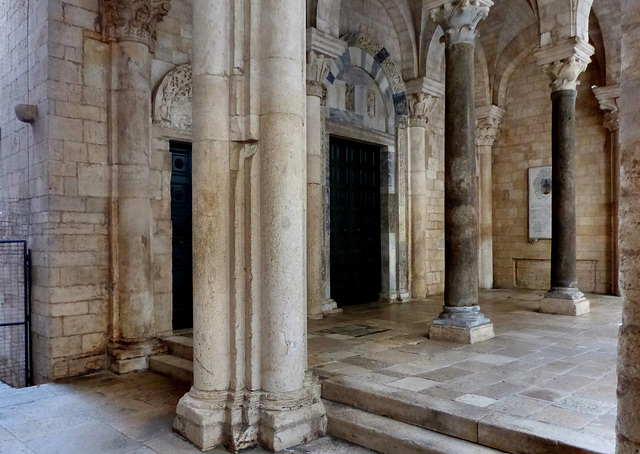Trani - Chiesa di Ognissanti
Trani - Chiesa di Ognissanti
Trani - Chiesa di Ognissanti
Barletta - Il Castello
Barletta - Colosso di Barletta
Barletta - Basilica del Santo Sepolcro
Barletta - Basilica del Santo Sepolcro
Barletta - Chiesa di Sant'Andrea
Barletta - Chiesa di Sant'Andrea
Barletta - Duomo di Barletta
Barletta - Duomo di Barletta
Barletta - Duomo di Barletta
Barletta - Duomo di Barletta
Barletta - Duomo di Barletta
Barletta - Duomo di Barletta
Barletta - Duomo di Barletta
Barletta - Duomo di Barletta
Barletta - Duomo di Barletta
Manfredonia - Abbazia di San Leonardo in Lama Vola…
Manfredonia - Abbazia di San Leonardo in Lama Vola…
Manfredonia - Abbazia di San Leonardo in Lama Vola…
Manfredonia - Abbazia di San Leonardo in Lama Vola…
Manfredonia - Abbazia di San Leonardo in Lama Vola…
Trani - Chiesa di Ognissanti
Trani - Chiesa di Ognissanti
Trani - Chiesa di Ognissanti
Trani - Chiesa di Santa Teresa
Trani - Chiesa di San Francesco
Trani - Cattedrale di San Nicola Pellegrino
Trani - Cattedrale di San Nicola Pellegrino
Trani - Cattedrale di San Nicola Pellegrino
Trani - Cattedrale di San Nicola Pellegrino
Trani - Cattedrale di San Nicola Pellegrino
Trani - Cattedrale di San Nicola Pellegrino
Trani - Cattedrale di San Nicola Pellegrino
Trani - Cattedrale di San Nicola Pellegrino
Trani - Cattedrale di San Nicola Pellegrino
Trani - Cattedrale di San Nicola Pellegrino
Trani - Cattedrale di San Nicola Pellegrino
Trani - Cattedrale di San Nicola Pellegrino
Trani - Cattedrale di San Nicola Pellegrino
Trani - Cattedrale di San Nicola Pellegrino
Trani - Cattedrale di San Nicola Pellegrino
Trani - Cattedrale di San Nicola Pellegrino
Trani - Cattedrale di San Nicola Pellegrino
Location
See also...
Keywords
Authorizations, license
-
Visible by: Everyone -
All rights reserved
-
38 visits
Trani - Chiesa di Ognissanti


Trani may have been founded by Greek settlers, but the known history starts late. After the fall of the Western Roman Empire, it was dominated by Lombards, Byzantines, Saracens and again Byzantines. With the conquest of southern Italy by the Normans and after 50 days of siege by Robert Guiscard´s troops, Trani became part of the Norman Empire in 1073.
Already under the Byzantines, Trani had become an important port for trade with the Orient. The heyday was in the time of the crusades in the 12th and 13th centuries, when crusaders and merchants mainly went to the Holy Land from Bari and Trani. It became an episcopal see in place of Canosa, destroyed by the Saracens. Frederick II promoted the Teutonic Knights and the Jewish community and built a massive castle. Under his rule, the city reached its highest point of wealth and prosperity.
The "Chiesa di Ognissanti" (= All Saints) was probably founded in the 12th and completed in the 13th century. It is located next to the harbour, from where many crusaders sailed off to the Holy Land.
The tradition links the church to the Templar Order, but following the documents, it is more likely that it was the church of the merchant colony of Ravello. It may well have been a place of blessing for the crusaders.
The church became the property of the bishop of Conversano and in 1479 was donated to the Lambertini family, that originated from, Ravello.
Since the 19th century, the church is as well known as "Chiesa del Purgatorio". It became the seat of several Confraternities. It served the parish up to 1975 and became the seat of the Secular Franciscan Order in the 1980s. In 2019 there was a sign that it is now "Sito ufficiale dei Templari Cattolici d´Italia".
.
The front opens to a small narthex.
Already under the Byzantines, Trani had become an important port for trade with the Orient. The heyday was in the time of the crusades in the 12th and 13th centuries, when crusaders and merchants mainly went to the Holy Land from Bari and Trani. It became an episcopal see in place of Canosa, destroyed by the Saracens. Frederick II promoted the Teutonic Knights and the Jewish community and built a massive castle. Under his rule, the city reached its highest point of wealth and prosperity.
The "Chiesa di Ognissanti" (= All Saints) was probably founded in the 12th and completed in the 13th century. It is located next to the harbour, from where many crusaders sailed off to the Holy Land.
The tradition links the church to the Templar Order, but following the documents, it is more likely that it was the church of the merchant colony of Ravello. It may well have been a place of blessing for the crusaders.
The church became the property of the bishop of Conversano and in 1479 was donated to the Lambertini family, that originated from, Ravello.
Since the 19th century, the church is as well known as "Chiesa del Purgatorio". It became the seat of several Confraternities. It served the parish up to 1975 and became the seat of the Secular Franciscan Order in the 1980s. In 2019 there was a sign that it is now "Sito ufficiale dei Templari Cattolici d´Italia".
.
The front opens to a small narthex.
- Keyboard shortcuts:
Jump to top
RSS feed- Latest comments - Subscribe to the comment feeds of this photo
- ipernity © 2007-2024
- Help & Contact
|
Club news
|
About ipernity
|
History |
ipernity Club & Prices |
Guide of good conduct
Donate | Group guidelines | Privacy policy | Terms of use | Statutes | In memoria -
Facebook
Twitter

Sign-in to write a comment.